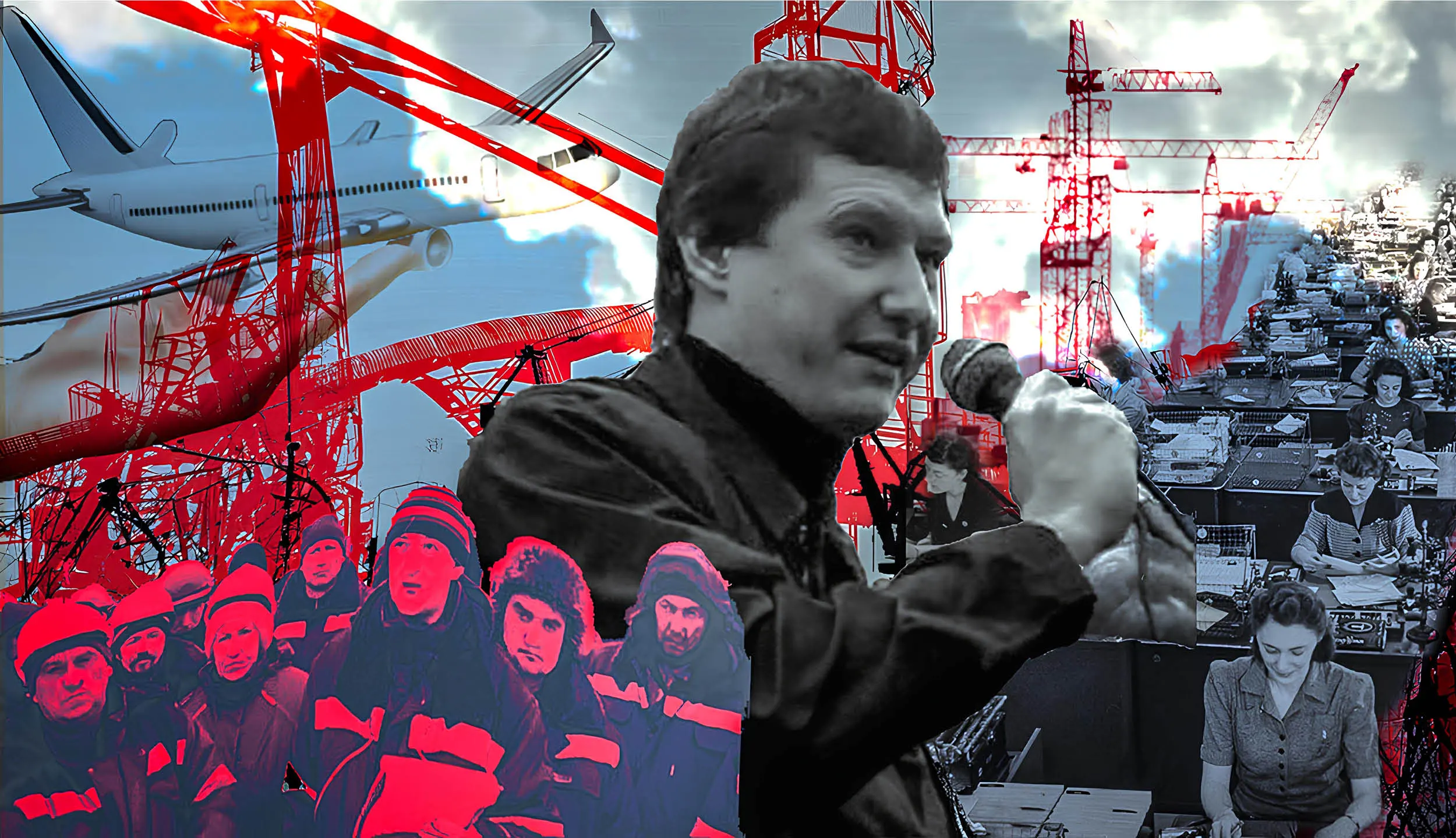The environment is one of the things that suffers the most in the relationship between the “center” and the “periphery” in empires. The recent protests in Bashkortostan provide a striking example. On one hand, very few people are indifferent to environmental issues; this is a problem that affects literally every one of us. On the other hand, environmental protest is often seen as a “safe” protest. Nature has an unquestionable value that few dare to speak against in public. But it is important to remember that Russian environmental policy also has its own unique history, with its own attendant internal conflicts. Of particular note in this history is the way in which the formation of environmental policy has repeatedly been driven by political tensions between different regions of the country.
The Russian Empire first faced the problem of industrial pollution of the environment in the 19th century, before environmental legislation and special regulatory authorities existed. The very first idea for a Russian institution devoted to fighting pollution did not come from the capital ministries of the Russian Empire. It came from Ukraine, where city dwellers, scientists, officials and industrialists tried, both en masse and on their own, to solve the problem of river pollution caused by sugar factories. Their ideas were so successful that the model provided by the Ukrainian provinces was soon adopted in Moscow. And, in the 1920s, it was according to the Ukrainian model that the Soviet Union planned to establish a global network of research institutes with a center in the capital. Why was it Ukraine that found itself at the forefront of the battle for clean water protection? How did the local community manage to force influential industrialists to meet them halfway?
Rivers, Money and Sugar
The largest polluters of Ukrainian rivers in the past century have been sugar factories, which were first built in the area in the 1870s. At this time, local planters started growing sugar beets (an invention of German beet breeders), and industrialists mastered new methods of processing them. Owing to these conditions, beet sugar, produced in the Russian Empire, entered the European market and began to drive out American cane sugar.
By the end of the 19th century, beet sugar gained ground as a unique product. It commanded a niche which seemed boundless at the time and has only continued to grow since then. Where sugar was once so expensive that common city folk could only afford to use it as a medicine or preservative, now sugar was affordable, and people began inventing new ways to use it — adding sugar to coffee and tea, enjoying sweets, and flavoring alcoholic beverages. People rarely considered the fact that others were paying a high price for their newly sweetened lifestyles. In the New World, this price was enslaved labor; in the territory of modern-day Ukraine, the price was the unprecedented pollution of rivers that peasants and coastal citizens depended on for their survival.
The first sugar manufacturers built their factories near rivers, since production required large amounts of water. These rivers also served as ditches for draining wastewater. Such arrangements of production, waste management, and water supply systems used to be commonplace. For centuries, city dwellers treated their household waste in the same way. However, things changed greatly after the Industrial Revolution. The amount of factory sewage reached such volumes that the river water near large sugar factories could not even be used for bathing, and fish died in it and did not reappear for several years.
For example, in 1880, the Kharkov-Mykolaiv railway manager complained to local authorities about a noxious odor emanating from one of the station water towers. The strong stench made the tower impossible to be around, to say nothing about actually using it (and the locomotives that did use the water broke down). The people of Trostyanets (now Sumy Oblast, Ukraine), upon draining runoff from a nearby sugar factory into the Boromlya River, discovered the river full of “sleeping” fish. At first, they were excited by this discovery and gathered fish in buckets, fried them, boiled them, and ate them right on the riverbank. However, a couple of days later they found the river had become a much less pleasant place; the fish had died, and tons of decomposing organic matter made the river unbearably smelly and unfit for daily use. Benefits for industrialists meant disaster for the common people, who were less well-off and less protected; not only were they inconvenienced, but they also often lost their livelihoods.
Nevertheless, the status of sugar manufacturers increased and strengthened every year. The Russian Empire was interested in promoting “Russian sugar” on the European market, and the high incomes of industrialists led to increasing deductions to the public budget. The owners of large enterprises maintained a level of influence comparable to that of local governors and often ignored these local officials, dealing instead with high-ranking patrons in St. Petersburg. It seemed that locals had no chance against these large industrialists and their St. Petersburg defenders.
Principles and Approaches
The situation was further complicated by the fact that at the end of the 19th century, the problem of industrial pollution was extremely new, with few guidelines on how to solve it. By that time, neither relevant practical recommendations nor legal norms had been established for assessing the effects of industrial pollution and distributing responsibility for these effects. Legislators had yet to determine whether polluting river water would be considered a crime committed by factory owners, and if so, what the punishment for this crime would be.
During this period, the “polluter pays” principle, already taking hold in other European countries, began to find support in the Russian Empire. Under this principle, if locals suffered losses due to the fault of a factory owner, these losses were to be calculated and refunded at the culprit’s expense. Nowadays, this approach no longer seems entirely fair, as it implies that nature has a price at which it can be purchased. Paying fines essentially meant buying a license to pollute, and often at a price that wealthy industrialists found quite acceptable. At that time, however the “polluter pays” principle seemed an acceptable solution. At the very least, it gave city dwellers and peasants the right to lodge complaints against manufacturers and expect success in court if disputes arose.
Representatives of the capital ministries at this time did not support granting autonomy to regions, even for solving problems that would soon be called “environmental issues.” Government authorities considered any delegation of powers from the “center” to the “periphery” a sign of weakness due to their commitment to the ideology of imperial “integrity.” When governors tried to take independent action against negligent industrialists, they often faced resistance from capital officials, who would ask them to hold off until general all-Russian laws on the subject were publicized (which did not happen until the middle of the 20th century). These officials also desired restraint from governors for economic reasons: the central government did not want some regions to have more favorable conditions for industrial development than others. For these same reasons, many governors themselves hesitated to curb the pollution of rivers by factories and plants. Such measures could cause an outflow of money to other regions and reduce the regional budget. This cycle continued until the governor of one of the Ukrainian provinces broke this “vicious circle” by taking a risk and throwing down the gauntlet to local industrialists.
The Quest for Compromise
In 1880, Pyotr Apollonovich Gresser, a famous statesman and general, was appointed governor of Kharkov. His contemporaries described him as a bad politician, but a brave soldier. He did not serve as governor for long and soon became head of the St. Petersburg police, which, under his leadership, solved the assassination attempt on Emperor Alexander III.
Indeed, Gresser’s early governorship was marked by contentious politics. In his second month as governor, he came into conflict with the most influential people in the region. In a letter to Kharkov’s sugar manufacturers, Gresser demanded they take immediate measures against river pollution and report to him on the work done. The industrialists’ response was no less decisive. They reminded the governor of their patrons in the Capital Ministry of Finance and the importance of sugar production to national interests. However, both sides agreed that it was becoming increasingly difficult to ignore the river pollution, and the time for joint problem-solving had come.
In order to reduce pollution, it would first be necessary to detect the pollution, measure it, and identify its source. Only then could reasonable measures to eliminate the pollution be proposed. The Ukrainian provinces of the Russian Empire were one of the few regions that already possessed the essential prerequisites for such an undertaking. These provinces were home to two large universities — St. Vladimir University in Kyiv and Kharkov University — where the professors were trained to conduct research and propose solutions to the problem based on the models of their European colleagues.
Sugar manufacturers concluded that it would be expedient for them to encourage collaboration between university experts and officials, within the bounds of commissions financed by local industrialists. These commissions would inspect the factories, evaluate potential dangers to water purity, and propose projects for inexpensive treatment facilities if necessary. If factory owners followed all the commission’s recommendations and the pollution level didn’t decrease (or didn’t decrease enough), charges against the factory owners would be dropped. The sugar manufacturers hoped that these industry-funded commissions would not be inclined to take action against the industrialists acting as their patrons, and that city authorities would not allow local governors to impose excessive restrictions. But these assumptions proved wrong.
First, reputation and scientific ethics turned out to be more important to the experts on the commissions than funding from sugar manufacturers. Even before their first field inspections, these experts stated that the task of scientists was to conduct research, not to fulfill orders. Many manufacturers were surprised when the commissions began to inspect their enterprises thoroughly and demand the installation of expensive filters.
Secondly, the looming threat of cholera forced the St. Petersburg ministries to finally admit the advantages of delegating reservoir protection to the provinces instead of forcing governors to wait until all-Russian laws were passed. Local officials and experts had a fuller grasp of regional environmental conditions and a deeper understanding of what measures would be most effective in a given time and place. By the end of the 19th century, the Ministry of Internal Affairs granted the provincial governments the right to issue orders on sanitary matters and obliged industrialists to implement these orders.
Commissions created by sugar manufacturers to protect themselves against claims from provincial administrators eventually transformed into independent institutions well-suited for effectively reducing river pollution. However, the story does not end here: once exclusive to the Ukrainian provinces, these institutions soon gained traction in other regions, and were soon in demand throughout the empire.
Temporary Things
The beginning of the 20th century was an enormously complex period in Russian political history. The protests and unrest that erupted in 1905 following a shooting at a peaceful demonstration in St. Petersburg forced the Russian Empire to make concessions. Once again, political demands often coincided with environmental ones: people demanded not only civil rights and freedoms, but also the right to a clean environment. And the authorities had to react.
In addition to the Ukrainian provinces, the Moscow industrial region also faced serious problems with river pollution. Numerous textile factories polluted local rivers with substances much more toxic than waste from sugar beet processing. For a long time, Moscow governors prioritized economic gain over the environment and turned a blind eye to this pollution. However, as cities and industry continued to grow, the governors’ tolerance gradually diminished, and, in the early 1910s, provincial authorities began to threaten industrialists with prison terms for failing to comply with sanitary requirements. But even if the manufacturers wanted to stop polluting the rivers, not all of them knew how to purify wastewater. The combination of a lack of experience and familiarity with environmental regulations, public discontent, and strict demands from the authorities caused panic among industrialists.
At this point, factory owners in the Moscow industrial region recalled the experiences of the Ukrainian provinces. In order to protect themselves from new lawsuits, they proposed to create a similar institution to the one used by the Ukrainian provinces to successfully manage river pollution while engendering universal respect and maintaining their authority. Calling for the development of new approaches in environmental policy, Moscow industrialists aimed to follow in the footsteps of England, Germany, and now the “Southwestern Territory”.
In 1912, Emperor Nicholas II signed a proclamation creating the Temporary Committee for the Protection of Water. This committee was to work for five years with financial support from industrialists and eventually offer them technical measures for wastewater treatment. But there is nothing more permanent than temporary things: after 5 years, this committee not only did not close, but also successfully survived both revolutions, continuing to work as if nothing had happened. In Soviet Russia, it was known as the Central Committee for the Protection of Water under the Supreme Council of the National Economy.
In fact, this Central Committee, inspired by the Ukrainian model, became the first specialized institution in Russian history focused on combating industrial water pollution. Responsible for both monitoring compliance with national standards and studying local conditions, the Committee was truly progressive for its time. Ironically, in the early 1920s, it was proposed to create divisions of the Committee throughout the country, including in Ukraine, the very place where the idea of this institution was born.
In the early 1930s, the Committee became part of the new Geological and Water Survey Institute and lost its independence. It was no longer as relevant as it once was — factories were no longer private property, and industrial development and the desire to “catch up and overtake the West” became key priorities of the Soviet government. Nevertheless, this innovation marked a milestone in the history of environmental policy and laid the foundation for new approaches to solving environmental problems.
The Nature of Empires
The fight against water pollution caused by sugar factories in Ukraine is a vivid example of the toxic relationship of empires to the environment. Imperial expansion is based on the idea that everything and everyone within an empire’s territory should support its power and work to strengthen it. At different periods of history, this idea was realized in different ways and with different intensities. Nowadays we can see it in a number of legislative initiatives and propaganda cliches circulating in modern Russia.
Today, as in the days of the Russian Empire, the main task of a woman from the point of view of the state is not to become happy and carve out a career for herself, but to give birth to children and maintain domestic life in order to ensure reproduction and population growth. Men are expected to show strength and endurance, in order to be ready to kill and die for the state if the state requires it. The main priority in raising children today is to prepare them to fulfill these social roles, and to prepare them quickly and effectively. By design, the goals of these constant struggles are unattainable; the achievement of one task will always be followed by the chasing of new ones. This corresponds to the capitalist ideals of endless technological progress and ever-growing economic profit.
However, exploitation concerns not only people, but also nature. As one of the fathers of environmental history, James Scott, wrote, the state views the environment through “fiscal glasses” to simplify the management process. Instead of forests that create picturesque landscapes and biological diversity, capital managers see cubic meters of firewood and commercial timber; instead of protected natural areas around Lake Baikal, they see convenient places for profitable tourism operations. For the owners of the Bashkir Soda Company and their patrons, Mount Kushtau (Twin Mountain) is not a natural monument, important and valuable for local residents, but a convenient limestone deposit for development. The same thing happened in Ukraine in the 19th century: for sugar producers, rivers were just a convenient place to dispose of waste. While peasants used the rivers for utilitarian purposes as well, they were more interested in preserving their purity than industrialists and city officials.
Historical experience proves that nature is not divorced from people and is in fact closely intertwined with the social order. It is pointless to expect the government to give up fiscal opportunities and industrialists to give up profit. Only the local community can push them to do this, since only they are able to “see the forest for the trees” and imbue the environment with meaning. The state of natural areas largely depends on whether residents of the regions can speak out and be heard and, of course, on their ability to participate in decision-making.
It is no coincidence that writer Jenny Price, in her “ecological manifesto,” calls for “stopping saving the planet”. This goal is too abstract to motivate people to take real action. Sometimes, to solve global problems, we need to focus on what is happening around us right now. Pollution of the rivers where we swam and fished as children, deforestation of the forest where we liked to pick mushrooms, overwhelming smog that we have to breathe… All these are much stronger and more tangible incentives for environmental protests and participation in ecopolitics than concerns about climate change as a planetary problem or about the disappearance of certain biological species in another country or region, far from where we live. But not every regional protest leads to change, much less to ecopolitical shifts at the national level. What was it that made the Ukrainian provinces’ confrontations with big business so successful?
First of all, the outcome of this struggle depended on the local community, and this community turned out to be quite strong and persistent in its demands. City dwellers and farmers filed lawsuits, wrote complaints and petitions, while university professors refused to make their examinations convenient for industrialists, despite receiving funding from them. Importantly, it was public pressure that eventually forced the central authorities to abandon the unitary approach to governance and transfer some power to local authorities. This story shows once again how destructive the centralization of power can be. The consequences of such centralization of power can be seen both in the history of the Russian Empire and in the modern history of Russia.
___________
The creation of the article was supported by Rosa-Luxemburg-Stiftung.







